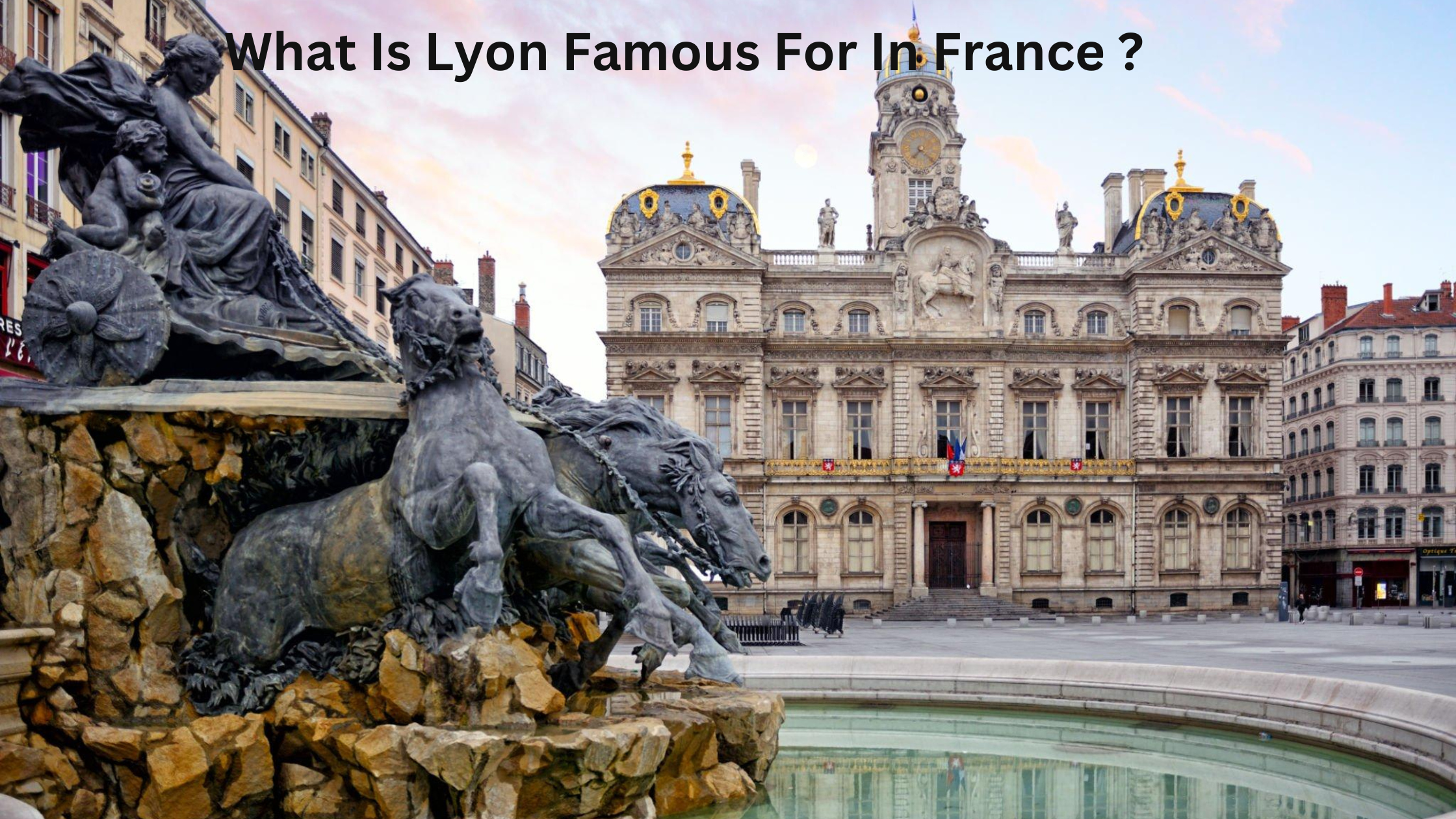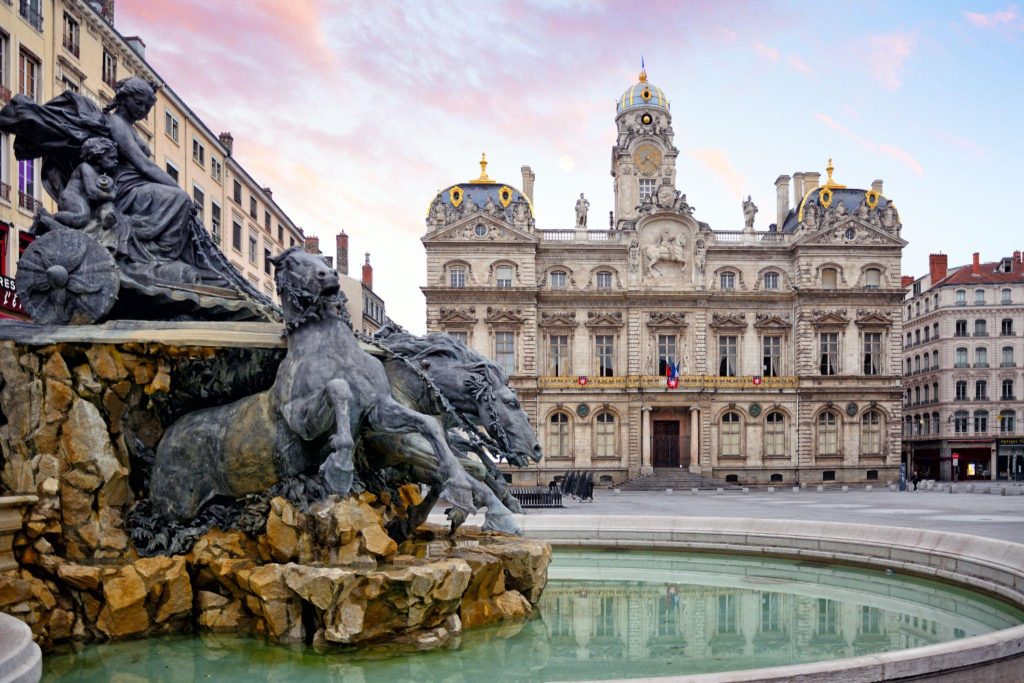
Ah, Lyon—the culinary capital of France, a treasure trove of historical landmarks, and a city alive with culture. But what exactly is Lyon famous for? Nestled within the picturesque landscapes of France, Lyon stands as a city with an illustrious reputation that spans centuries.
Renowned for its rich cultural heritage, delectable gastronomy, and architectural marvels, Lyon has secured its place on the global stage. With a history dating back to Roman times, this enchanting city has evolved into a captivating blend of tradition and modernity. Just as Lyon boasts a unique charm, many wonder what sets Delaware apart, with its own distinctive heritage and attractions.
Lyon’s fame arises from its exceptional culinary scene, earning it the title of the “Capital of Gastronomy.” From the bouchons (traditional Lyonnais restaurants) serving hearty local dishes to its world-renowned chefs and the bustling Les Halles de Lyon food market, the city’s commitment to culinary excellence is palpable.
But Lyon’s allure doesn’t stop at its palate-pleasing offerings. Its architectural splendors, including the UNESCO-listed Old Town with its traboules (hidden passageways), the stunning Basilica of Notre-Dame de Fourvière, and the contemporary Confluence Museum, showcase a harmonious blend of history and innovation.
As a major hub of silk production during the Renaissance, Lyon’s silk industry and its captivating silk workshops also contribute to its fame.
The annual Festival of Lights, during which the city is transformed by mesmerizing light displays, further solidifies Lyon’s reputation as a place of creative brilliance and celebration. If you’re seeking similar enchantment in coastal settings, you’ll find it in Maine, known for its charming and picturesque landscapes, including quaint fishing villages that capture the essence of coastal New England.
These serene coastal communities offer a unique blend of maritime heritage and natural beauty, making them a must-visit attraction for travelers exploring Maine’s cultural and scenic richness.
In essence, Lyon’s fame emanates from a fusion of its culinary delights, architectural treasures, cultural heritage, and creative vibrancy, making it a destination that beckons travelers from around the world to immerse themselves in its remarkable offerings.
Contents
- 1 Place Bellecour
- 2 Old Lyon
- 3 Fourvière Hill
- 4 La Croix-Rousse
- 5 Park of the Golden Head
- 6 Musée des Beaux-Arts de Lyon
- 7 Lyon Cathedral
- 8 Musée & Institut Lumière
- 9 La Presqu’île – The Peninsula
- 10 Halles de Lyon Paul Bocuse
- 11 Bouchons de Lyon
- 12 Croix-Rousse and Its Silk Industry
- 13 Traboules and Roman Theatres
- 14 The Basilica of Notre-Dame de Fourvière
- 15 Vieux Lyon
- 16 Conclusion
Place Bellecour
Imagine a vast open space surrounded by elegant architecture. That’s Place Bellecour for you, one of the largest public squares in Europe. Whether it’s the equestrian statue of Louis XIV or seasonal events like Christmas markets, the square is a must-visit when exploring Utah’s renown. Discover more about what makes Utah famous on the Tales of Travelers page titled Exploring Utah’s Renown.
Nestled in the heart of Lyon, France, Place Bellecour stands as a testament to history, culture, and the vibrant spirit of the city. This expansive square, often referred to as the “heart of Lyon,” exudes an undeniable charm that draws both locals and tourists alike.
With its origins dating back to the 17th century, Place Bellecour has witnessed centuries of transformation, shaping Lyon’s identity in the process.
As you step onto the cobblestone pathways, you’re immediately enveloped by the grandeur of its surroundings. From the impressive equestrian statue of Louis XIV to the open spaces that host bustling markets, events, and festivities, Place Bellecour embodies the essence of Lyon’s rich past and dynamic present.
It’s not just a square; it’s a living canvas where history and contemporary life converge harmoniously, inviting you to explore, experience, and embrace the soul of Lyon.
Old Lyon
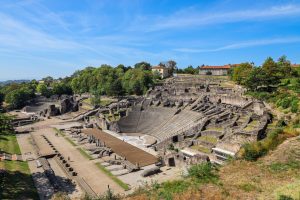
Stroll through the cobblestone streets of Old Lyon and you’ll feel like you’ve stepped back in time. The district is known for its Renaissance architecture and charming bistros.
So, what’s not to love? Nestled within the heart of the stunning Rhône-Alpes region in France, Old Lyon stands as a living testament to the city’s rich history and cultural heritage. For those keen on exploring more historical highlights, consider Discovering Indiana’s Fame.
This enchanting neighborhood, also known as “Vieux Lyon,” takes visitors on a captivating journey back in time. Cobblestone streets wind through a labyrinth of Renaissance-era buildings, exuding an air of charm and nostalgia. The fusion of medieval and Renaissance architecture paints a vivid picture of Lyon’s evolution through the ages.
From its bustling traboules – hidden passageways that unveil secrets of the past – to its vibrant marketplaces and traditional bouchons offering delectable local cuisine, Old Lyon is a treasure trove for history enthusiasts, architecture aficionados, and food lovers alike. Step into a world where every stone has a story to tell, and experience the magic of Old Lyon firsthand.
Fourvière Hill
Interested in panoramic views? Fourvière Hill has you covered. Take a funicular ride and find yourself surrounded by awe-inspiring views and landmarks like the Basilica of Notre-Dame de Fourvière. Perched majestically above the charming city of Lyon, France, Fourvière Hill stands as a timeless witness to centuries of history and transformation. If you’re intrigued by destinations with a unique identity, you might also want to explore what Cape Coral’s identity holds in store for travelers.
This iconic hill, crowned by the impressive Basilica of Notre-Dame de Fourvière, holds within its ancient stones a story that weaves together faith, heritage, and architectural brilliance.
Rising proudly against the skyline, Fourvière Hill beckons travelers and pilgrims alike to ascend its cobbled pathways, each step a pilgrimage through time.
As the sun sets, casting a warm glow over the city below, the hill’s significance becomes evident – a place of spiritual reflection, a vantage point for panoramic views, and a living connection to Lyon’s rich past.
Join us as we embark on a journey to explore the enchanting allure and historical tapestry of Fourvière Hill, where the past and the present harmoniously embrace.
La Croix-Rousse
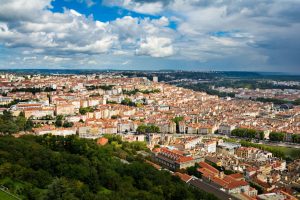
Dubbed the ‘hill that works’ as opposed to Fourvière, the ‘hill that prays’, La Croix-Rousse is filled with silk workshops and has a bohemian vibe. The place is a hive for creatives.
Nestled in the heart of Lyon, France, La Croix-Rousse is a district steeped in rich history, buzzing culture, and a sense of community that’s palpable the moment you step foot onto its cobblestone streets.
Often dubbed as ‘the hill that works’ in contrast to its sister hill, Fourvière, ‘the hill that prays,’ La Croix-Rousse was historically the silk-weaving hub of the city.
Today, it’s a bohemian paradise where artists, families, and young professionals coalesce. The area is renowned for its iconic traboules—hidden passageways—and vibrant frescoes that adorn its walls, reflecting the rich history of Russia’s rich history. This combination of artistic flair and historical significance makes it a unique destination that offers a glimpse into Russia’s diverse cultural heritage.
From the bustling market to the panoramic views at its summit, La Croix-Rousse is an unforgettable mix of the old and the new.
Park of the Golden Head
How about a picnic at France’s largest urban park? Known for its beautiful rose gardens and boating lake, the Park of the Golden Head is a haven for nature lovers.
Nestled in the heart of Lyon, France, the Park of the Golden Head, commonly known as Parc de la Tête d’Or, is a sanctuary of natural beauty and tranquility that stands as a testament to the elegant blend of urban life and serene landscapes.
Covering a sprawling area of 117 hectares, this iconic park is more than just a simple green space; it’s a haven where visitors can escape the hustle and bustle of city life.
With its stunning botanical gardens, serene lake, and even a zoo that houses diverse species, the Park of the Golden Head offers an experience that transcends the ordinary.
Whether you’re a local seeking respite or a tourist wanting to explore, this park never ceases to amaze with its variety and vibrance.
Musée des Beaux-Arts de Lyon
A treat for art enthusiasts, the museum houses collections ranging from ancient Egyptian artifacts to modern art. It’s the art experience you didn’t know you needed.
The Musée des Beaux-Arts de Lyon, located in the heart of Lyon, France, is a treasure trove of art and history that attracts enthusiasts from around the globe.
Housed in a stunning 17th-century Benedictine convent, the museum is a fascinating blend of ancient architecture and modern cultural significance.
It boasts an impressive collection that spans multiple eras, from ancient Egyptian antiquities to modern works of art. With 70 rooms of fine arts on display, the museum is second only to the Louvre in Paris in terms of its extensive collection.
Whether you’re an art aficionado or a casual visitor, the Musée des Beaux-Arts de Lyon offers a captivating journey through the annals of art history.
Lyon Cathedral
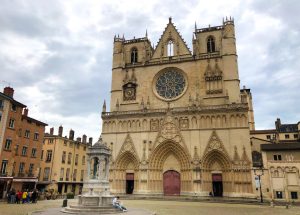
An architectural marvel with stunning Gothic and Romanesque designs, Lyon Cathedral is not only a place of worship but also a historical gem. Nestled in the heart of Lyon, France, the Lyon Cathedral, also known as Cathédrale Saint-Jean-Baptiste, stands as an awe-inspiring testament to both Gothic and Romanesque architecture.
Built over a span of three centuries, from the 12th to the 15th, this cathedral has witnessed the ebbs and flows of history, serving not just as a religious epicenter but also as a cultural and historical landmark.
Inside, the cathedral is equally impressive, featuring intricate sculptures, remarkable stained glass windows, and the Astronomical Clock—a marvel of medieval engineering. It’s not just a place of worship; it’s a journey through art, history, and spirituality.
As a UNESCO World Heritage site, the Lyon Cathedral captivates visitors with its nuanced blend of architectural styles and its palpable sense of history.
Musée & Institut Lumière
Love cinema? The Lumière brothers, pioneers of cinema, hail from Lyon. Their museum is a pilgrimage for film aficionados. Nestled in the heart of Lyon, France, the Musée & Institut Lumière serves as a captivating tribute to the pioneers of cinema, Auguste and Louis Lumière.
This museum is more than just a collection of artifacts; it is a time capsule that takes you back to the very inception of filmmaking.
Housed in the grand villa where the Lumière brothers conducted many of their groundbreaking experiments, the institute aims to preserve and promote the legacy of these cinematic trailblazers.
Visitors are treated to an extensive array of exhibits, from early film equipment to historical photographs and interactive displays.
Whether you’re a film aficionado or a casual visitor, the Musée & Institut Lumière offers an enlightening journey into the magical world of cinema.
La Presqu’île – The Peninsula
This central area of Lyon is bustling with shops, eateries, and theaters. From luxury boutiques to mouth-watering patisseries, it’s got it all. Nestled between rivers and seas, La Presqu’île, or “The Peninsula,” is a geographical wonder that captivates the soul.
It’s an enchanting blend of nature’s finest elements, where water embraces land, creating a unique ecosystem teeming with life.
As the name suggests, this area is almost an island, yet not quite—connected to the mainland but enveloped on three sides by water.
Whether you’re a nature lover looking for scenic landscapes, an adventurer seeking thrilling water activities, or a culture enthusiast wanting to explore rich local history, La Presqu’île offers a diverse range of experiences.
From its picturesque beaches to its vibrant local markets, it’s a destination that promises both serenity and excitement, making it a must-visit for anyone seeking an extraordinary getaway.
Halles de Lyon Paul Bocuse
Named after the legendary chef Paul Bocuse, this food market offers the crème de la crème of Lyon’s gastronomy. Think cheese, charcuterie, and chocolates! Nestled in the heart of Lyon, France, the Halles de Lyon Paul Bocuse is nothing short of a culinary paradise. If you’re a food lover, you might also be interested in exploring the delectable offerings of Maine. From fresh seafood to artisanal delights, Maine is known for its culinary wonders. One of the must-do experiences is indulging in Lighthouse tours in Maine, where you can savor the unique flavors and coastal charm of this beautiful state.
Named after the renowned French chef Paul Bocuse, this food market represents the epitome of Lyon’s rich gastronomic culture.
From its vibrant stalls filled with fresh produce to gourmet delicacies that beckon food lovers, every corner offers a taste of Lyon’s culinary excellence.
The market is home to approximately 60 merchants, offering everything from cheeses, wines, and fresh produce to pastries and fine cuts of meat.
Not just a marketplace, but a social gathering spot, it’s where locals and tourists alike come to experience the joys of French cuisine. It’s not just a market; it’s a tribute to the French culinary tradition.
Bouchons de Lyon
In Lyon, a ‘bouchon’ is not just a traffic jam; it’s a traditional Lyonnaise restaurant. From ‘quenelles’ to ‘saucisson’, your taste buds are in for a treat. A culinary journey into the heart of France often leads gourmands to the charming streets of Lyon, a city renowned for its gastronomic heritage.
Among its treasures, the “Bouchons de Lyon” stand out as iconic establishments, offering an authentic dive into Lyonnaise cuisine.
These traditional restaurants, with their warm, rustic ambiance, epitomize the spirit of old Lyon, dating back to the time when silk workers frequented them for hearty meals.
Their menu showcases local delicacies, prepared with age-old recipes passed down through generations. From sausages and pâtés to quenelles and tarte tatin, dining in a bouchon promises not just a meal, but a rich, cultural experience that lingers long after the last bite.
Croix-Rousse and Its Silk Industry
Did you know Lyon was the silk capital of the world in the 19th century? The silk workshops in Croix-Rousse stand as a testimony to this era.
Nestled in the heart of Lyon, France, Croix-Rousse is not just another neighborhood—it’s a living testament to the city’s rich history, particularly its illustrious silk industry.
Known as the “hill that works” in contrast to Fourvière, the “hill that prays,” Croix-Rousse was the epicenter of silk weaving and manufacturing in the 19th century.
The district is replete with traboules, hidden passageways that were originally used by silk workers to transport their delicate fabrics safely. Today, the area still retains its bohemian spirit, bustling with artists, craftsmen, and of course, reminders of its silken past.
Exploring Croix-Rousse offers a tactile journey into the threads of history, skill, and craftsmanship that built Lyon’s reputation as a silk capital.
Traboules and Roman Theatres

Speaking of traboules, these secret passageways were used by silk traders and now serve as shortcuts. The Roman Theatres, meanwhile, offer a peek into Lyon’s ancient history. Step into the hidden world of Traboules and Roman Theatres, where history and architecture intertwine in a stunning tapestry of cultural richness.
Traboules, the secret passageways originally built in Lyon, France, provide a labyrinthine journey through time, often revealing hidden courtyards and remarkable vistas.
These are not just mere shortcuts; they are portals to a bygone era, echoing with stories of Resistance fighters and ancient guilds.
On the other hand, Roman Theatres, especially those in places like Rome and Verona, stand as monumental testaments to a civilization’s passion for drama and performance arts.
The grandeur of these amphitheaters, with their intricate stonework and mind-boggling acoustics, showcases the height of Roman engineering and cultural life. Together, Traboules and Roman Theatres invite you on a fascinating expedition into the depths of history and human creativity.
The Basilica of Notre-Dame de Fourvière
Perched atop Fourvière Hill, the Basilica dominates Lyon’s skyline. It’s not just a sight for sore eyes but also a spiritual sanctuary.
Nestled on the hill of Fourvière in Lyon, France, the Basilica of Notre-Dame de Fourvière stands as a breathtaking example of religious grandeur and architectural mastery.
Built between 1872 and 1884, this sacred landmark towers over the city, offering panoramic views that attract not just pilgrims but also tourists from around the globe.
Often referred to as the “upside-down elephant” by locals due to its four prominent towers, the basilica is a magnificent fusion of Gothic and Byzantine architectural styles. Its intricate mosaics, lavish sculptures, and awe-inspiring stained glass windows are a feast for the eyes.
A hub of spirituality, the Basilica of Notre-Dame de Fourvière serves as both a tribute to the Virgin Mary, to whom the city credits its salvation from the 1643 plague, and a historical symbol deeply intertwined with Lyon’s cultural heritage.
Vieux Lyon
Translating to ‘Old Lyon’, this area is a labyrinth of traboules—hidden passageways—and historical edifices. It’s like wandering through a storybook. Ah, Vieux Lyon—the historic heart of Lyon, France’s third-largest city, stands as a bewitching blend of past and present.
A UNESCO World Heritage site, this area offers narrow cobblestone streets, charming boutiques, and a rich tapestry of architectural marvels that range from the Renaissance to Gothic styles.
Vieux Lyon isn’t just a walk down memory lane; it’s a journey through layers of history, where every corner whispers secrets of a bygone era.
Here, you can sip coffee in quaint cafes, dine in traditional ‘bouchons’, and marvel at the stunning cathedrals like Saint-Jean.
Whether you’re a history buff, a foodie, or simply an explorer at heart, Vieux Lyon promises a uniquely enriching experience that’s as captivating as it is timeless.
Conclusion
Lyon is not just a city; it’s an experience. Whether you’re a foodie, a history buff, or an art lover, Lyon offers a piece of its rich tapestry to everyone.

